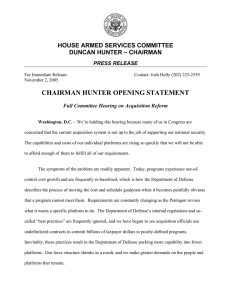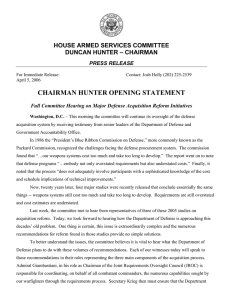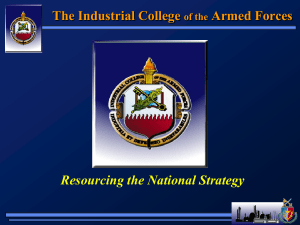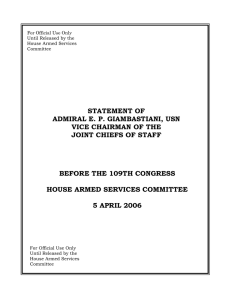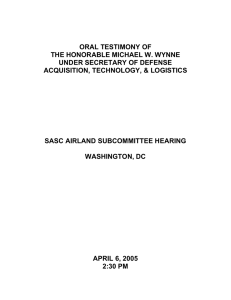Elements of Acquisition Reform Robert J. Hermann DoD Consultant and
advertisement
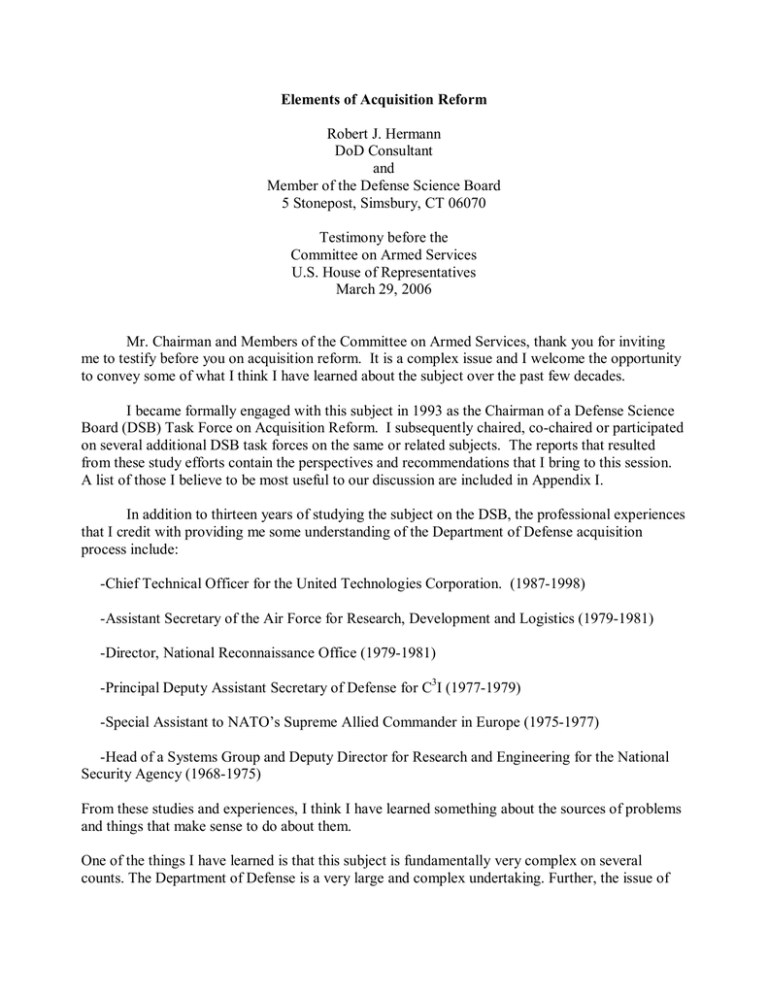
Elements of Acquisition Reform Robert J. Hermann DoD Consultant and Member of the Defense Science Board 5 Stonepost, Simsbury, CT 06070 Testimony before the Committee on Armed Services U.S. House of Representatives March 29, 2006 Mr. Chairman and Members of the Committee on Armed Services, thank you for inviting me to testify before you on acquisition reform. It is a complex issue and I welcome the opportunity to convey some of what I think I have learned about the subject over the past few decades. I became formally engaged with this subject in 1993 as the Chairman of a Defense Science Board (DSB) Task Force on Acquisition Reform. I subsequently chaired, co-chaired or participated on several additional DSB task forces on the same or related subjects. The reports that resulted from these study efforts contain the perspectives and recommendations that I bring to this session. A list of those I believe to be most useful to our discussion are included in Appendix I. In addition to thirteen years of studying the subject on the DSB, the professional experiences that I credit with providing me some understanding of the Department of Defense acquisition process include: -Chief Technical Officer for the United Technologies Corporation. (1987-1998) -Assistant Secretary of the Air Force for Research, Development and Logistics (1979-1981) -Director, National Reconnaissance Office (1979-1981) -Principal Deputy Assistant Secretary of Defense for C3I (1977-1979) -Special Assistant to NATO’ s Supreme Allied Commander in Europe (1975-1977) -Head of a Systems Group and Deputy Director for Research and Engineering for the National Security Agency (1968-1975) From these studies and experiences, I think I have learned something about the sources of problems and things that make sense to do about them. One of the things I have learned is that this subject is fundamentally very complex on several counts. The Department of Defense is a very large and complex undertaking. Further, the issue of national security is imbedded in the political and social structure of the nation with all of the diversity of opinions and values that this brings with it. This complexity is multiplied by the fact that whenever and wherever acquisition reform is discussed, those discussing it have very diverse backgrounds with differing concepts of what acquisition means and different terms to describe the issue. As a result, there are many ways to miss-communicate when discussing acquisition reform. For today, I would like to put forward some propositions that represent my attempt to communicate what I believe are the ideas that are most important. 1. Acquisition is not just about buying things. From my perspective the role of the Department of Defense is to create, deploy and employ armed forces to defend and support the political interests of the country. The things it must “ acquire”or put in place are joint, allied and coalition military forces. The end product of the enterprise is effective fielded forces for today and for the future. 2. There are many observers and commentators on what is wrong with the DoD and each will have their own version. My summary follows; -The Department does not have a plan for what it is trying to achieve in outcome terms; it makes no attempt to measure how well it is achieving its objectives, and it has no system for understanding the true cost of any of its activities. This fragments the decision making, leads to overly optimistic cost and schedule estimates and results in destabilized program execution. -The DoD Requirements process is very destructive. It separates the question of what is needed from the cost of fulfilling that need. The Requirement is usually fixed by a committee of people that have neither mission responsibility nor financial accountability. This Requirement is passed as unbreakable guidance to a procurement process that has no right or competence to make trades between the performance specified by the requirement and the cost and schedule implications of implementing the requirement. “ Requirements”should inform the judgment of accountable executives but should not dictate performance outcomes. -The Combatant Commanders who have the ultimate mission responsibilities of the Department are not required or permitted to effectively participate in the make up of the forces needed for the future missions of their Command. Although there are operational plans for tomorrow, there are no guiding plans for the evolving future force. -The Combatant Commands do not have adequate technical support to manage the very technologically rich system that is their force or to contribute to the evolution of that force for the future. -The Department spends a great deal of its resources under the name of Logistics but does not have a quality logistics system. The management of this area is fractionated, the costs are huge and the effectiveness of the process is mediocre. -The way that DoD implemented Goldwater-Nichols removed the leadership of the Armed Services from their Title 10 organize, train and equip role. This removed an important source of military competence from the process and placed undue dependence on the destructive Requirements process. This was not required by the law and no legislative action is required to fix the problem. The following five propositions recommend actions to address these issues. 3. The Department of Defense needs a Business Plan. Any enterprise that is trying to achieve a mission with measured resources within some schedule needs a Business Plan. It is needed to codify mission objectives and apply discipline to the allocation of resources to mission. This is the key recommendation to highlight and is included in several of the listed DSB studies. An important element in the management concept surrounding the Business Plan is the accountability of DoD officials who are assigned roles and missions within the Department. As such, this concept stresses the judgment of mission accountable executives and places that judgment in a matrix of resources, output mission and schedule. The most recent and most complete manifestation of this recommendation is provided in the recent DSB Report on “ Transformation: A Progress Assessment”issued in January of 2006. Copied below are the relevant sections of that report. “DoD Business Practices DoD needs, but does not have, a multi-year business plan capable of relating resources to mission purposes. An effective business plan would give decision makers a clear understanding of the need for--and impact of-- resource decisions. While the Department has a number of complex mechanisms and processes for resource allocation, the need is for a fully interoperable system that would succeed as an executable business plan. In addition, confusion remains over roles in identifying needs, proposing and choosing solutions, executing programs, and overseeing performance. Figure 1 illustrates an effective and efficient allocation of roles within the context of existing laws and directives. There are four groups of players within the DoD: the Secretary of Defense and his staff; the Chairman, Joint Chiefs of Staff (CJCS) and his staff; the Combatant Commander (COCOM) responsible for conducting operations; and the Force Providers, comprised of the Services and Defense Agencies. The figure is intended to convey that while all the groups participate in most of the activities required to provide and operate effective forces, there should be accountable leaders for each role. Much of the following description reiterates current practice. However, the items in italics are areas where roles need to be clarified and enforced. The discussion following the figure addresses those areas. The COCOMs integrate force capabilities to conduct the DoD’ s operational missions. They should lead the process of identifying the capability needs that require higher priority, since they have the operational responsibility to employ all the Armed Forces as a joint team. These commands should also lead the process of assessing the capability needs of the approved solution. At present, the lead in these roles defaults to the Force Providers and Joint Staff. The Force Providers are responsible for providing and sustaining ready forces with the needed capabilities. They have the expertise and institutional capabilities to propose solutions to identified capability needs (including the systems engineering capability to ensure that solutions are viable) and to execute approved programs. The acquisition authority chain excludes the most knowledgeable Force Provider leadership from the role of acquiring capabilities. The Force Providers must also take the lead role in ensuring that materiel solutions support, and are supported by, the full range of Doctrine, Organization, Training Materiel, Leadership, Personnel, Facilities (DOTMLPF). The Secretary and his staff supported by the CJCS and his staff choose the solutions to capability needs, allocates resources to execute the decisions and oversee program execution. At present, the Force Providers and Joint Staff lead much of this effort. The Secretary also • Enforce Accountability in the Priority Decision Process • Advise SecDef • Joint Concepts & Doctrine • Oversee operational CJCS planning Joint Staff • Assess strategies & support SecDef OSD • Conduct joint operations Force Combatant • Develop operational Providers Commands concepts • Identify needed capabilities* Accountability Lead • Assess capability of solutions • Choose solutions* • Allocate resources • Oversee Program execution • Enforce the Business Plan** • Provide and sustain ready forces • Propose solutions • Systems engineering* • Execute programs*** • Integrate DOTMLPF * Defaulted to another authority ** Not available *** Goldwater-Nichols implementation 8 Figure 1. Mechanism for the Priority Decision Process enforces the Business Plan. At present there is no plan that qualifies as a Business Plan. The CJCS, supported by the Joint Staff, advises the Secretary of Defense and the President on a range of defense strategy, mission assignment, Force capability, and operational matters. Figure 2 illustrates the flow of activity in creating and executing the business plan: The Secretary of Defense, supported by the CJCS, will define, assign, and adjust missions The CJCS leads the Joint Concepts process with heavy Combatant Command (COCOM) participation The COCOMs identify needed capabilities supported by the Joint Staff, and with strong support from the Force Providers The Force Providers lead the process of proposing solutions The Secretary of Defense, supported by the CJCS and Joint Staff, chooses solutions; the Secretary and his staff also integrate the solutions into the business plan—specifying what is to be done, in what time period, with what resources, and with what output The Force Providers are then fully accountable for delivering the capability on time and within allocated resources, while the Secretary of Defense’ s staff monitors the overall process Various steps in this process create feedback into earlier steps of a continuous cycle of change within resource constraints. However, the discipline for the system comes from the Business Plan. Figure 2. Business Plan Activity Flow Focusing the mechanisms and processes on mission needs dictates that resources are accounted for by mission as well as by Force Provider. In this case, the mission purposes are described as the missions of the combatant commanders. There are at least two compelling reason for adding accounting by mission purpose. The first is that for combatant commanders’inputs on priority need to be credible, they must pass through the crucible of the hard trade-offs within the mission resources of the combatant commander. The second is that if the purpose of allocating the Department’ s resources is to support missions then they must be accountable by mission purpose. Figure 3 illustrates the needed matrix of accounting for resources by mission (identified as the output) and by Force Provider (who uses the resources as inputs to create the needed capabilities). Note that the resources are not allocated to the combatant commands. They are still allocated to those responsible for delivering the needed capabilities –the Force Providers There is concern that accounting fro resources by mission will be difficult and imperfect, since the concept will be new to the DoD. The Task Force agrees that while the DoD may experience some initial difficulty, this process can be accomplished without excessive effort or the need for perfection. The approach only needs to maintain the basic principles while transitioning from the current approach by Force Provider. There is concern that accounting fro resources by mission will be difficult and imperfect, since the concept will be new to the DoD. The Task Force agrees that while the DoD may experience some initial difficulty, this process can be accomplished without excessive effort or the need for perfection. The approach only needs to maintain the basic principles while transitioning from the current approach by Force Provider. The governing product needs to be a metric-based, multi-year, resource constrained, output- •Account for resources by m ission and by force and support provider Year 2, etc. Year 1 Accounting Allocations Services Defense Agencies Other Support CoCom 1 CoCom 2 CoCom 3 CoCom 4 Needs to be about right to serve the intended purpose Subtotals CoCom 5 CoCom 6, etc. Subtotals TOTAL: $400B 11 Figure 3. Matrix of Accounting for Resources by Mission oriented business plan that allocates resources to mission purposes, constrained by expected resources, executed by the Force Providers with progress measured against the plan objectives. 4. The Combatant Commanders who have the ultimate mission responsibility for operating the joint forces should have a greater role in defining the force capabilities needed to perform their mission. To be a part of that process, the Secretary of Defense must require that they play this role. They must also be given visibility of the budget and financial affairs of the department so that they can integrate these factors with their own mission imperatives into their recommendations to the Secretary. Without access to the money issues, the Combatant Commanders will remain beyond participation in the core processes for determining the force development plans of the Department. Money counts in these decisions and they need access to participate. The Business Plan Matrix outlined in 2. above would provide that visibility and participation This matrix is not a budget document. It is a management tool designed to discipline the capability needs formulation process by forcing the customer –the combatant command –to base priority of need on a value –cost –schedule linkage. Further, the matrix is only one management tool, albeit a powerful one. In using this tool, there will inevitably be difference is views between Combatant Commanders who are likely to focus on direct mission needs and Services and Defense Agencies that focus on broader issues. Nonetheless, this approach is important in disciplining the choices and forcing the needed dialogue to ensure that the customer’ s unique understanding, emanating from their immersion in mission issues, has a powerful voice in the choices. 5. The Regional Combatant Commands need systems engineering and systems integration help. The Armed Services have large numbers of systems engineers that deal with the integration issues involved with each Service’ s platforms and operating units. The Defense Agencies that supply specialized services such as DISA, NSA and the NRO have systems engineers dedicated to their functional mission. However, the Department does not have the institutions or skills to address the complicated systems represented by the joint forces. A modern military force is one of the most complex and technology rich enterprises known to many but those who operated and plan for these forces have almost no systems engineering support. The DSB Report on “ Enabling Joint Force Capabilities”deals with this subject and is quoted below. “Provide operational architectures and systems engineering support to combatant commanders for C2, networks and information integration (C2 & NII) needs There have been recent changes in the Unified Command Plan (UCP) that should over time move the combatant command towards a greater contribution to operational architectures and joint interface systems. For example, JFCOM has been assigned expanded responsibilities and authorities overseeing and directing joint Battle Management and Command and Control (BM&C2) capabilities for joint integration and interoperability. The purpose is to facilitate the creation and development of doctrine, requirements and integrated architectures for joint BM&C2 interoperability and connectivity. The new Strategic Command has a set of global responsibilities for joint forces capabilities to include global joint command and control services, global information operations, global ballistic missile defense, and an extensive role in global surveillance and reconnaissance. These new assignments will necessitate new relationships with the sources of technical and engineering expertise which will in turn increase both their inclination and capability to contribute to innovative, future thinking not currently characteristic of most combatant commands. There are four fundamental unfilled needs to be addressed: An organization and process for providing systems engineering support to combatant command, A stronger process for creating joint operational architectures so that force providers have a framework in which their programs must fit, Closer and more formal ties with the Service Organizations responsible for acquiring and fielding the joint systems, and A means of harmonizing C2 and NII needs across all of the joint arena from OSD/JCS, Services/defense agencies (including intelligence) and especially the combatant commands. The architecture and systems engineering approach should be truly “Enterprise”based systemof-system engineering. Fig. 4 illustrates an approach to meeting these needs. A multi-Service organization would be formed in Joint Forces Command to provide mission operational architectures. This organization would need to include people with experience across the operational world. It would report to a new sub-unified command in JFCOM, which would also be the source of systems engineering expertise to JFCOM and to the theater combatant commands. Because of the specific global missions assigned to STRATCOM in this area, this command would also have to develop a special relationship with STRATCOM. The organization would be small since the logical source of the expertise would be the Services, in the form of dual-hatted Service NII and ISR organizations, characterized in Fig. 4 as Integrated NII Commands. Fig. 4 Joint Operational Architectures and Systems Engineering Support for Command and Control, Networking and Information Integration (C2 and NII) Secretary of Defense Military Departments Joint Forces Command Joint C2 and NII Systems Command Integrated Army Command Integrated Navy Command Theater Combatant Commands Joint Operational Architectures Integrated Air Force Command •The Military Departments C2 and NII commands would be dual-hatted •Joint Forces Command provides C2 and NII systems engineering services support to theater combatant commands as needed Dual-hatting these commands provides at least three benefits. It provides the needed level of expertise without duplicating existing capabilities in the Services and defense agencies. It helps ensure that joint needs and systems define integrated C2, NII and ISR architectures and standards and that service systems programs conform to these needs and standards. It provides the acquisition structure to acquire compatible C2 and NII programs and to fix existing C2 and NII interoperability problems. Acquisition programs would continue to be assigned to a Service, defense agency or intelligence community acquisition organization. In order for the Joint C2 and NII Systems Command to have the needed influence, some part of the overall related programs budget would need to be controlled by the command though acquisition programs would continue to be executed by the Services and defense agencies.” 6. A new Logistics Command should be formed that encompasses the Transportation Command, the Defense Logistics Agency and provides a dual reporting line for the Service Logistics organizations. The 2005 DSB Summer Study on Transformation addresses this issue and is quoted here. “Logistics is, by any measure, big business in the Department, employing over 1 million people and carrying an inventory of roughly $67 billion, with a significant part of that inventory no longer relevant to activities and systems being supported. One measure of responsiveness is distribution of in-stock items in response to user orders. Since 1996, the logistics system has improved its delivery time from 26 to 21 days in comparison to large commercial operations that routinely deliver in 1-3 days. Transformation of logistics capabilities will be heavily dependent on integrated business systems and educated and motivated people who understand what is expected. In current practice, there is an internal transaction for each segment in the supply chain (e.g., from depot packaging to depot shipping; from depot shipping to package consolidation into truck-size loads; from truck movement to strategic shipping mode; and from strategic transportation to theater receiving, repackaging, movement, etc.). Furthermore, the system optimizes each segment (e.g., filling the trucks or rail cars for efficient use, optimizing the efficiency of the strategic transportation, repackaging for efficient use of theater transport). Optimizing each segment inevitably sub-optimizes the major objective of end-to-end movement from source to user. Integrated business processes supported by integrated business systems are essential in place of the currently fractionated process using some 600 different information systems and system architectures that apply technology to legacy practices rather than best practices. Over the past several decades, there have been large numbers of studies, recommendations, new processes, very large information systems projects, and new organizations created in search of an effective end-to-end logistics supply chain. In one of the many prior efforts to forge an end-toend supply change, U.S. Transportation Command (USTRANSCOM) was assigned the additional mission of Distribution Process Owner (DPO). While this was an important step, it did not go far enough to meet the objective of an effective supply chain. The necessary step is to assign a joint command the authority and accountability for providing this essential support to global operations. This Joint Logistics Command would subsume the current USTRANSCOM mission, would absorb the Defense Logistics Agency (DLA), and would be supported by the Service logistics commands in a component command role. The Service logistics commands would continue to perform their Service functions, as is the case with other component commands. Theater commanders would continue to be responsible for harmonizing the logistics flow demand with operations in the theater. System program managers would retain responsibility for the life cycle support plan and for configuration control of the supported system. An integrated logistics information system is also necessary for an effective end-to-end supply chain. Numerous commercial enterprises exist that regularly practice and employ these means. The command should form an external board of advisors comprised of personnel from the commercial sector with the appropriate industry expertise and experience. The Secretary of Defense should create a Joint Logistics Command: •Responsible for global end-to-end supply chain, •That includes the TransCom mission, DLA, Service logistics and transportation commands as components to JLC with: o Regional Combatant Commanders retaining operational control of the flow of intheater logistics; and o Program Managers retaining responsibility for lifecycle logistics support plan and configuration control. An integrated logistics information system will be essential to eliminate the need for multiple systems with multiple transactions across multiple seams. The USD/AT&L should: •Lead the work to create an integrated logistics information system, and •Appoint an external advisory board of relevant industry experts to assist in guiding this effort. 7. The DoD should restore the role of the leadership of the Armed Services that was removed by its implementation of Goldwater- Nichols. This is covered in the DSB Report on “ Transformation: A Progress Assessment”issued in January of 2006. “The DoD implementation of the acquisition aspects of the Goldwater-Nichols act provided an acquisition chain of authority outside the Force Provider chain of authority as illustrated in Fig. 4 below: SecDef DepSecDef Defense Acq. Exec. Secretary Undersecretary Service Acq. Exec. Service Chief Materiel Cmnd CJCS COCOM Service Component Reporting chain Coordination/ support PEO** Program Mgr 13 Figure 4. The Acquisition Chain of Authority The issues -- and an inevitable contribution to poor performance in acquisition -- is that the most senior operational judgment –the Service chief, material command commander, Service component commander to the combatant command, and hence the combatant commander –is excluded from the acquisition decision chain. In the absence of this accountable operational judgment, the minimum risk approach for the acquisition chain is slavish dedication to often outdated specification that were approved –years before by the Joint Requirements Oversight Council (JROC), numerous Defense Acquisition Board actions, and contract arrangements. This inevitably leads to large cost and schedule overruns. To restore accountability to the Force Provider and to leverage experienced operational judgment and inherent authority, the acquisition chain of authority should be modified to include the senior leadership of the Force Providers as shown in Figure 5 below. SecDef DepSecDef Defense Acq. Exec. Secretary Undersecretary* CJCS Service Chief COCOM Materiel Cmnd Service Component PEO** Program Mgr Reporting chain Coordination/ support * Undersecretary as Acquisition Exec ** Dual-hatting PEO requires waiver 14 Figure 5. Revised Acquisition Chain of Authority This change in the chain of authority requires no change to the law. It does require a waiver to DoD directive to dual-hat the PEO. The organization shown in Figure 5 would assign the Service Undersecretary are the Service Acquisition Executive. This would provide the cleanest line of authority. However, this is not essential to the concept of direct access to the Defense Acquisition Authority and accountability by the Force Provider senior leadership. The Secretary of Defense should restructure the acquisition process to give Force Providers civilian and military leadership clear responsibility and accountability through the Service chain of authority for delivering approved capabilities -----------------------------------------------------------------------------------------------------------These are the points I choose to highlight as highest in priority even though there are many other issues that need to be dealt with to create a quality “ Big A”acquisition process for the DoD. They include: -Muli-agency processes for addressing the major security problems of the nation. -Operational concept development. -The quality of the technical work force in Government and Industry -Managing the supporting technological and industrial base -The role of competition in the process -Balancing “ fairness”with enterprise results -Allied and coalition force development Appendix I: Abbreviated List of DSB Studies 2005 Summer Study - Transformation: A Progress Assessment Vol. I (2006) Enabling Joint Force Capabilities (2003) Acquisition Reform Phase IV –on metrics (1999) Command, Control, Communications, Computers, Intelligence, Surveillance and Reconnaissance (C4ISR) Integration (1997) Achieving and Innovative Support for 21st Century Military Superiority (1996) Defense Acquisition Reform, Phase I 1993
